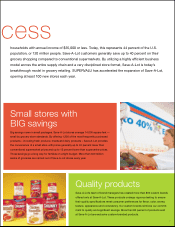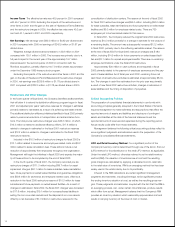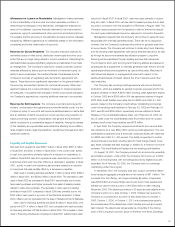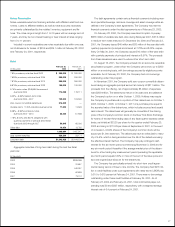Albertsons 2002 Annual Report Download - page 19
Download and view the complete annual report
Please find page 19 of the 2002 Albertsons annual report below. You can navigate through the pages in the report by either clicking on the pages listed below, or by using the keyword search tool below to find specific information within the annual report.
Dividend payment dates are on or about the 15th day of March, June,
September and December, subject to the Board of Directors approval.
New Accounting Standards
In June 2001, the Financial Accounting Standards Board (FASB) approved
Statement of Financial Accounting Standard (SFAS) No. 141, “Business
Combinations” and SFAS No. 142, “Goodwill and Other Intangible Assets.”
SFAS No. 141 requires that all business combinations initiated after June
30, 2001 be accounted for under the purchase method and addresses the
initial recognition and measurement of goodwill and other intangible assets
acquired in a business combination. SFAS No. 142 requires companies to
cease amortizing goodwill that existed at June 30, 2001. For the Company,
this amortization of existing goodwill will cease on February 24, 2002.
SFAS No. 142 also establishes a new method of testing goodwill for
impairment on an annual basis or on an interim basis if an event occurs or
circumstances change that would reduce the fair value of a reporting unit
below its carrying value. The adoption of SFAS No. 142 will result in the
discontinuation of amortization of goodwill and goodwill will be tested for
impairment under the new standard beginning in the first quarter of fiscal
2003. The Company has determined that discontinuing the amortization
of goodwill will have a $0.35 per diluted share impact on earnings per
share. The Company is currently measuring the impact of goodwill impair-
ment and will complete this evaluation by the end of the first quarter of
fiscal 2003.
In June 2001, the FASB issued SFAS No. 143, “Accounting for Asset
Retirement Obligations,” which addresses financial accounting and report-
ing for obligations associated with the retirement of tangible long-lived
assets and the associated asset retirement costs. The Company plans
to adopt the provisions of SFAS No. 143 in the first quarter of fiscal 2004.
Common Stock Price
SUPERVALU’s common stock is listed on the New York Stock Exchange under the symbol SVU. At fiscal 2002 year end, there were 7,155 shareholders of
record compared with 7,243 at the end of fiscal 2001.
Common Stock Price Range Dividends Per Share
Fiscal 2002 2001 2002 2001
High Low High Low
First Quarter $16.46 $12.60 $22.88 $14.00 $0.1375 $0.1350
Second Quarter 21.80 15.00 20.25 14.69 0.1400 0.1375
Third Quarter 24.10 18.81 18.19 14.00 0.1400 0.1375
Fourth Quarter 24.96 18.85 17.81 11.75 0.1400 0.1375
Year $24.96 $12.60 $22.88 $11.75 $0.5575 $0.5475
In August 2001, the FASB approved SFAS No. 144, “Accounting for the
Impairment or Disposal of Long-Lived Assets.” The Company plans to
adopt the provisions of SFAS No. 144 in the first quarter of fiscal 2003.
The Company is currently analyzing the effect SFAS No. 143 and SFAS
No. 144 will have on its consolidated financial statements.
Quantitative And Qualitative Disclosures About Market Risk
SUPERVALU is exposed to market pricing risk consisting of interest rate risk
related to debt obligations outstanding, its investment in notes receivable
and, from time to time, derivatives employed to hedge interest rate changes
on variable and fixed rate debt. The Company does not use financial
instruments or derivatives for any trading or other speculative purposes.
SUPERVALU manages interest rate risk through the strategic use of
fixed and variable rate debt and, to a limited extent, derivative financial
instruments. Variable interest rate debt (commercial paper, bank loans,
industrial revenue bonds and other variable interest rate debt) is utilized to
help maintain liquidity and finance business operations. Long-term debt
with fixed interest rates is used to assist in managing debt maturities and
to diversify sources of debt capital.
SUPERVALU carries notes receivable because, in the normal course of
business, the Company makes long-term loans to certain retail customers
(see “Notes Receivable” in the Notes to the Consolidated Financial
Statements for further information). The notes generally bear fixed interest
rates negotiated with each retail customer. The market value of the fixed
rate notes is subject to change due to fluctuations in market interest rates.
At February 23, 2002, the estimated fair value of notes receivable approxi-
mates the net carrying value.
17
























